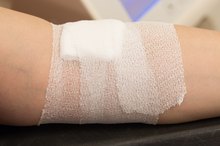Treatments for Cement Burns
Direct contact with wet cement might cause chemical burns to your skin or your eyes 2. Various construction materials, including concrete, plaster, grout and mortar, often contain Portland cement, a caustic alkaline binding compound that can induce a severe skin reaction with limited exposure. Because pain is not immediate, the worker might not realize the extent of the cement burn until later when the symptoms, including blisters, skin discoloration and dead skin appear (Reference 1).
Initial Care
Remove any clothing or boots if they contain wet concrete or other wet cement mixtures. The longer the wet cement is in contact with your skin, the greater the risk for suffering a cement burn. Brush away dry specks of cement and rinse the skin with lukewarm water for 20 minutes to remove any cement residue (Reference 2).
Neutralize
What Is Potassium Dichromate?
Learn More
Because the cement is highly alkaline, add a neutralizing agent such as white vinegar to the rinse water. Apply citrus juice, a neutralizing agent with mild acidic properties, if vinegar is not available. If you regularly work with wet cement, keep pH-neutral cleansers on hand (Reference 1).
Eyes
Cement burns to the eyes might result from not wearing safety eyewear when working with wet cement 2. Immediate rinsing of the eyes with clear water is necessary for at least 20 minutes Contact an ophthalmologist for advice, even if the worker does not experience pain or vision disturbance.
Monitor
Home Remedies for Minor Chemical Burns
Learn More
What appears to be reddened skin the day after contact with wet cement might become a severe, caustic burn in a few days. Initial symptoms might include a rash, followed by inflammation and itching, swelling and then blistering. Monitor the skin, and contact a health professional if symptoms worsen after a few days (Reference 2).
Avoid
Because the high calcium level in Portland cement leaches moisture from the skin, workers might think applying a lotion or skin-softening agent, such as lanolin, will protect and nourish the skin. But these products can trap the caustic solution on the skin's surface, where it can cause more damage (Reference 1).
Medical Treatments
If a cement burn is severe, it might require medical attention that could include antibiotic treatment, daily soaks of antiseptic, such as:
- iodine or povidone
- or hospitalization for debridement of the dead
- damaged tissue
Related Articles
References
Writer Bio
Glenda Taylor is a contractor and a full-time writer specializing in construction writing. She also enjoys writing business and finance, food and drink and pet-related articles. Her education includes marketing and a bachelor's degree in journalism from the University of Kansas.







